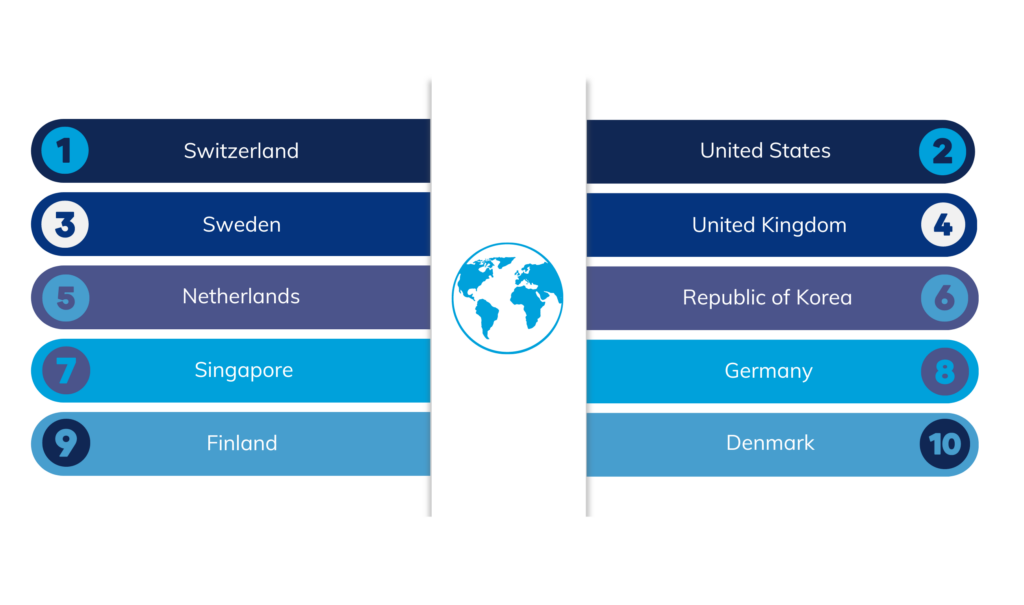The World Intellectual Property Organisation (WIPO) has officially released the 2022 Global Innovation Index (GII). The GII evaluates 132 countries, aiming to capture the position of their innovation ecosystems, looking at factors such as science and technology, labour productivity, industry diversification and creative goods exports.
For the twelfth year in a row, Switzerland has topped the index, followed by the United States, Sweden, the United Kingdom and the Netherlands. When looking at the countries improving their GII placement, China is quickly approaching the top ten, whilst India has entered the top 40 for the first time.

Global innovation hubs and China’s race to the top of indicator rankings
The GII also looks at the biggest technology innovation clusters for 2022. These ‘science and technology hubs’ look at the innovation centres in the world with the highest density of scientific authors and inventors. For the year 2022, the top science and tech hub is Tokyo–Yokohama, followed by Shenzhen–Hong Kong–Guangzhou (China and Hong Kong), Beijing (China) and Seoul (Republic of Korea). These clusters represent innovation output at a local level, rather than the global scale of the broad GII, and recognise that technology innovation can indeed be a localised phenomenon, shedding light on the communities of innovators worldwide.
It is also of note that Cambridge in the United Kingdom has risen to the global no.1 position in respect of science and technology intensity, that is the sum of patent and scientific publication shares divided by the area’s population. Mathys & Squire’s Cambridge office is proud to support the innovative companies and entrepreneurs that have contributed to this world-leading innovation ranking.
Furthermore, China’s growth within the GII has not gone unnoticed. Climbing to eleventh place in the global ranking indicates China’s recent intentions to foster a more innovative environment for their domestic inventors. When looking more granularly at the specific indicators used to determine the index, China officially ranks first for nine of out of around 80 indicators. These include key innovation areas such as patent by origin, labour productivity growth and PISA scales in reading, maths and science.
Future innovation trends – supercomputing and biotechnologies
China’s recent growth is not the only key takeaway from the GII. The WIPO also produced a list of future innovation trends to look out for, which are referred to as ‘innovation waves.’
The first of two developments is the digital age innovation wave, built around growth in supercomputing and artificial intelligence. The developments within this industry, particularly when considering intellectual property (IP), have already been seen recently in UKIPO’s guidance on inventions created by AI and their patentability. Increasingly, people are considering the future of IP through the lens of AI creations.
The second growth and innovation wave is built around breakthroughs in biotechnologies, nanotechnologies, new materials and other sciences. This trend surrounds the world of hybrid science, whereby the natural environment and modern technology interweave to generate technologically advanced, green solutions. The implications of the growth of nanotechnology stretch far beyond green tech; they possess the capability to expand to engineering and medical device innovations, with future potential to turn science fiction into reality.
It is apparent these two waves indicated by the WIPO will face some serious hurdles when it comes to their diffusion and adoption by sectors worldwide. These innovation waves, alongside growth trends highlighted in the 2022 results, are sure to make for an interesting year when it comes to analysing global development, prior to the 2023 GII. The role of IP during this time will be to ensure inventors have the security necessary to continue working on their new innovations, in order to foster a more fruitful environment for knowledge transfer, creativity and invention.

